Edible forest gardens
Acacias as pioneer species in an edible forest garden
One of the defining features of an edible forest garden is the process of instant succession.
As the planner of an edible forest garden, I have a (reasonably) clear idea of the end state that I’m looking for. This includes having all the ecosystem niches filled, so the garden is as stable as possible, requiring the minimum of maintenance effort.
Instead of just hoping for the best, instant succession involves planting a whole set of plants at the outset to shape what direction the garden takes. So in the one hit, you plant the edible trees, mid-storey bushes, herbaceous plants and groundcovers.
One of the key players in an early edible forest garden are pioneer species. These grow very rapidly, even in low fertility soil, to provide protection for everything that follows.
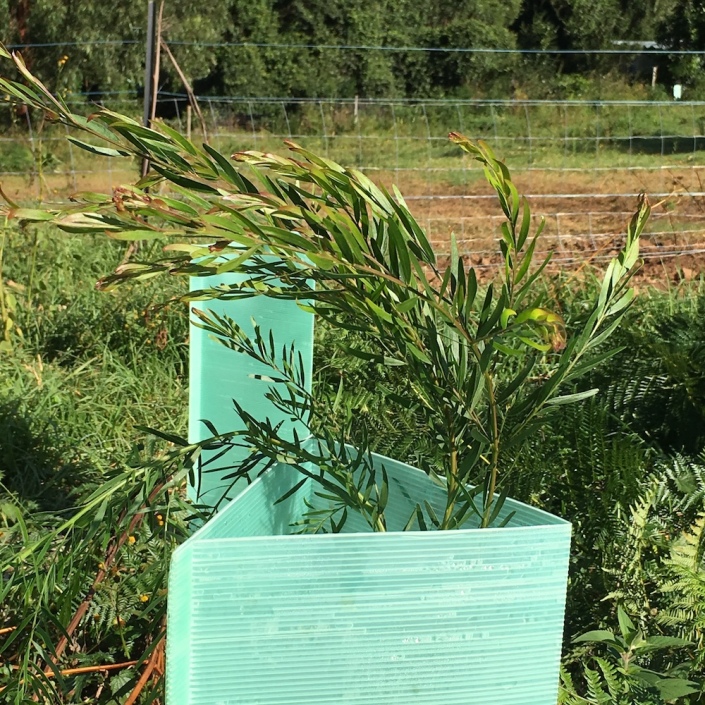
In an Australian context, acacias (wattles) provide an ideal pioneer species. There are hundreds of varieties, that grow from prostrate bushes to large trees, so there’s an acacia for every situation.
Best yet, acacias are nitrogen-fixing. They can also be pruned heavily, which adds this nitrogen into the soil, from the roots and fallen branches.
But that’s all in theory. In practice, the wallabies (or wombats?) ate all the acacia seedlings we planted, and the drought conditions probably didn’t help either.
Thankfully things are now going better to plan. As you can see from the photo above, the more recent acacia fimbriata seedlings have burst out of their tree guards and are heading for the sky. These will be allowed to grow into small trees, providing a temporary canopy for the fruit trees below.
In due course, they can be heavily pruned or coppiced, or potentially removed entirely, as the fruit trees reach full size.
Our first citrus patch: going to plan, or to ruin?
I could hear my neighbours thinking, when I proudly showed off our first citrus patch:
“This is what he’s been blogging about?!? What a mess! He must be mad!”
I can understand why they think that. The mainstream advice for an orchard, described in the most recent Gardening Australia magazine, is: “space the trees widely enough apart that you can easily mow between them”.
This isn’t what we’ve done. Instead, we’ve been creating a citrus guild.
To recap: the goal is to plant around the citrus tree with a variety of beneficial plants, bringing nutrient up from the soil, attracting beneficial bugs, and controlling grass (the enemy of all fruiting trees).
This is was my sketch of what it would look like:

But seeing the reality, you can understand why our neighbours are having second thoughts:
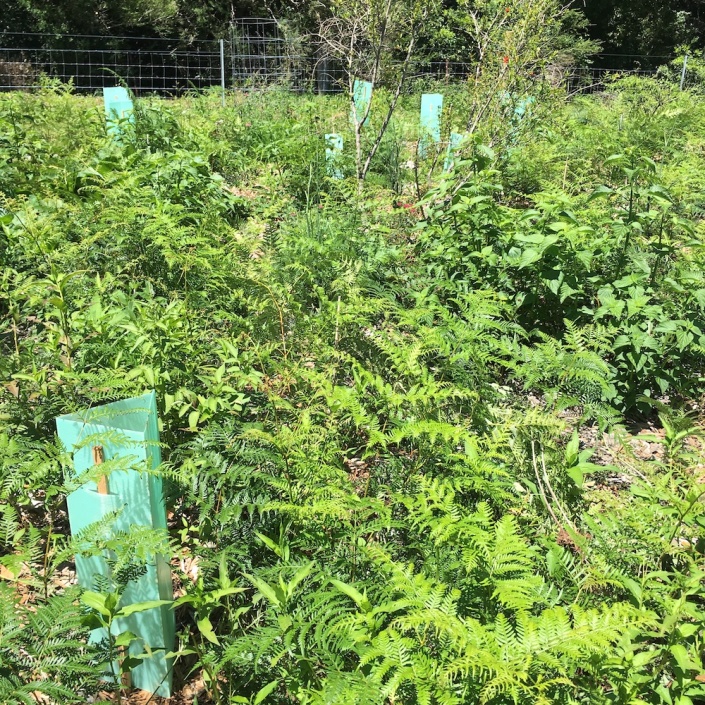
The growth has been extraordinary, a testament to the quality of our soil, and the benefits of breaking up compaction from years of horses grazing. Still, it’s hard to even spot the dwarf citruses amongst everything else.
The rapid growth of the bracken ferns has been a surprise, but I think in a good way. Since these ferns are known to act as ‘dynamic accumulators’, bringing up nutrients from the soil, they seem like an ideal groundcover. The grass certainly doesn’t stand a chance against it.
The salvias have pushed through and are flowering profusely. The rue, yarrow and fennel are all flowering to the benefit of beneficial bugs. The comfrey is growing, but is struggling against the bracken ferns, so we’ll see how that goes.
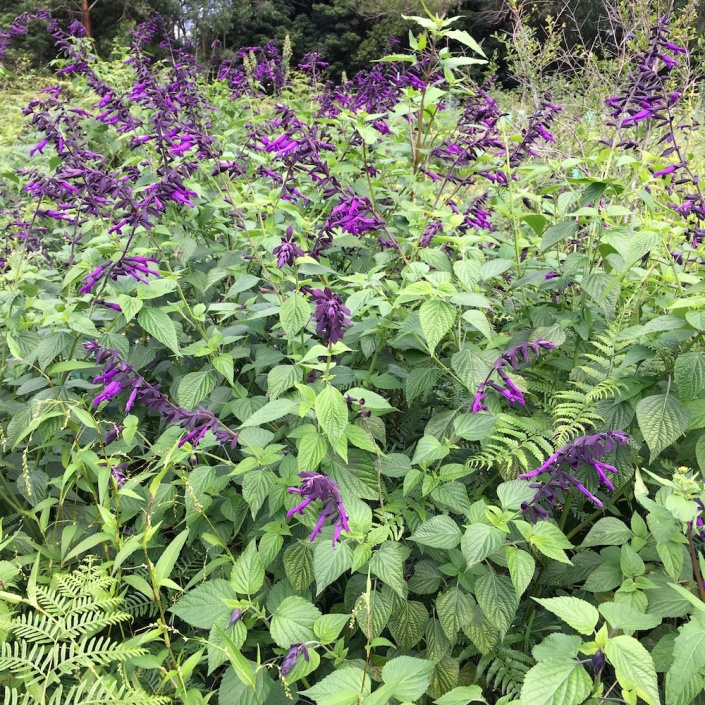
The citrus trees all suffered heavy transplant shock, but I’m hopeful they’ll start to take off in earnest next season, pushing above the ferns. The pomegranate at the centre of the patch also hasn’t thrived, but we have just had the driest summer in 20 years, so I’m hopeful for next year.
Watch this space, and I’ll continue to report on the journey of our edible forest garden patches … to success, or ruin.
(I’ll also post some aerial photos and videos shortly, which will give another perspective on how it’s progressing.)
Growing your own lilly pilly from foraged seeds
This is the season for lilly pillies (syzygium and acmena) to flower and fruit. And if you want a lilly pilly in your own garden, it’s easy: just find a local bush that has fruit you like the taste of.
The outer flesh of the fruit prevents germination, so eat that off. Then plant the seeds in some seed-raising mix. Wait and watch them grow!
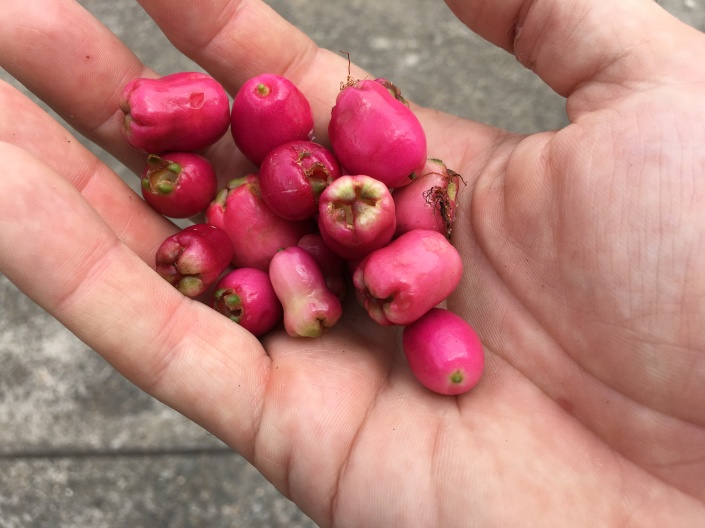
We’ve found them to strike very easily and to grow vigorously. Once they get bigger, divide them into individual pots. Then transplant them into the garden when they’re ready.

These particular plants are Syzygium Leuhmanii, which have a crisp cinnamon taste. We’re growing a whole hedge of them down at the farm, from Lewisham-collected seeds 🙂

Second citrus patch planted

Following on from our first patch of dwarf citrus, a family work gang has helped us plant out our second patch. This is of full-sized citrus, with supporting guild.
A few notes:
- With full-sized rather than dwarf citrus, patch 2 is a little under twice the size of patch 1.
- The ‘spine’ of the planting are three Elaeagnus Ebbingei a nitrogen-fixing plant that increases the fertility of fruit trees, and is highly-recommended for permaculture gardens.
- There’s a mix of native citrus (eg finger lime), introduced citrus (eg navel orange) and a few that are hybrids of the two (eg sunrise lime).
- I’ve snuck a few berry bushes into the understory on the Eastern side (currants and gooseberry). I want to test how they perform in increasing shade, as well as seeing whether all the fruit is eaten by birds, etc. Consider it a living experiment 😉
- As before, everything is sheet mulched, with a bunch of ‘in-fill’ plants to go in shortly to shade out any weeds.
With Spring coming, lets see how this patch goes!
Our vision for Lewisham Farm and its edible forest garden
The transformation of our 22ha property overlooking Nowra will take several decades. A core part of this journey is creating an “edible forest garden”, as described by Dave Jacke in his books with Eric Toensmeier.
One of the starting points is to document a clear vision or goal statement. There’s a few reasons for doing this:
- it’s hard to get somewhere if you don’t know where you’re headed!
- an edible forest garden requires long-term planning
- there are many different ways of creating a garden
- there are often multiple people involved, with different goals, but with the need for a common vision
In our case, Priscilla is all about country gardens & flowers, and I’m all about big-scale transformations. So we sat down, did some brainstorming, then some wordsmithing.
I’m sure this vision will change hugely over the coming years as we learn a heap, but this is where we’re starting. (Note that Jacke recommends writing the vision as we’ve already achieved the outcome)

At the centre of the property, the country-styled house is surrounded by a delightful cottage garden. Laid out in neat shapes, it provides a relaxed environment and a year-round supply of cut flowers.
Surrounded by vibrant rainforest on all sides, the broader property is devoted to an Australian ‘edible forest garden’ that provides an abundance of fruits, nuts and native bushfoods. Arranged as interconnected fields and ‘garden rooms’, the local micro-climates have been exploited to allow a great diversity of spaces, each with a very different feel and mix of plants.
There is also a tranquil pond with ducks, productive bee hives, a vegetable patch and a greenhouse for propagating plants.
Our friends and family have also enjoyed the escape from the city, as well as helping with every stage of the transformation. The small eco-cottages set in the more distant fields are rented out to provide a modest income.
This has been a decade-long journey, with the learnings shared with the wider permaculture community. We’ve been able to show how much can be done by part-time farmers, and how Australian rainforest plants can be integrated into a food-growing system. (1 August 2017)
First step towards an edible forest garden
As blogged about previously, our long-term goal for our South Coast property is to create an “edible forest garden“, following the books by Dave Jacke.
This week we took the first steps towards this big vision, with the planting of our first fruit trees.
The trees were all transplanted from Lewisham, with the bulk being citrus trees:
- Ruby grapefruit (dwarf)
- Cumquat x 2 (dwarf)
- Meyer lemon x 2 (dwarf)
- Kaffir lime (dwarf)
- Pomegranate (full-sized)
- Aniseed myrtle & Cinnamon myrtle
- Acacia (various, all shrubs rather than full-sized trees)
The plantings were carefully designed in advance to ensure that we get the most out of the trees, with the least maintenance work:
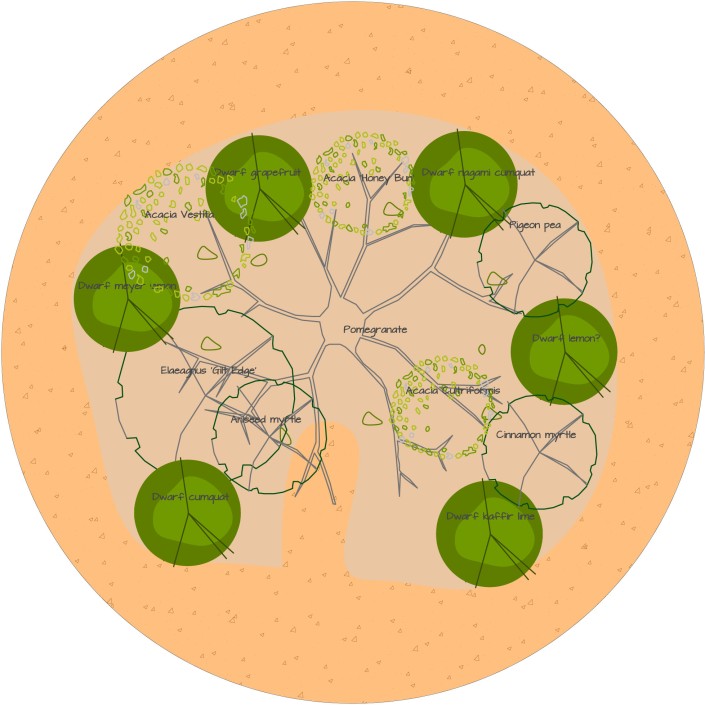
The design was laid out accurately on the ground using triangulation, to ensure that reality matched the plan.

After planting, the patch was sheet mulched, with a layer of cardboard covered by hardwood chip mulch. This should keep the weeds down long enough for the cover crops to do their work.

A few notes on the approach, with references back to Jacke’s book:
- The planting is done in patches, with are then combined to create the overall garden design.
- In this instance, it’s a polyculture patch (design pattern #44 from the book), which is a set of complementary plants that support and assist each other.
- As outlined in our post on citrus guilds, there’s a big focus on nitrogen-fixing plants to support the hungry fruit trees.
- The diagram above shows the eventual size of the trees (which will be some years off), and to achieve this an approach of instant succession (pattern #31) has been taken. This involves interplanting the gaps in the short term, to direct the eventual outcome.
- There are at least three layers in the patch (pattern #38), from ground covers, to the dwarf citrus up to the pomegranate (which while full-sized, is deciduous).
- A lumpy texture (pattern #39) of larger and smaller plants gives better light access, and confuses the pests.
- I’ve used a number of native species (pattern #43), including acacias (for nitrogen-fixing), plus aniseed and cinnamon myrtles (for culinary purposes).
- Underneath all the plants will be a thick ground-cover layer (pattern #49) that will be a mix of flowering plants to attract insects (pattern #42), and further nitrogen-fixers.
- The patch was fenced, with five strands of tensioned wire. This should deter the wallabies and wombats (note I didn’t say stop the animals, as that would be optimistic!).
All the preparation and planting work was knocked off by dad and myself in three days, making it about a man-week of work in total.

Phew! It’s been hard (but rewarding) work this week to get our first patch in place. I’m sure there will be huge successes and crushing failures to come, watch this space!
Giving breathing room for two of our fruit trees
It always amazes me to see trees planted by themselves in a sea of grass.
Not only does the grass compete fearsomely with the trees, but the grass encourages a bacteria-dominated ecosystem in the soil rather than a fugal ecosystem, which trees require. Trees also prefer to live in a tightly-bound forest of their peers, where their roots are interconnected, making it possible for them to share resources.

No wonder then that the two lonely fruit trees planted at Lewisham Farm have been struggling. We think they might be peaches, but we won’t know until we’re able to get them to a point of being healthy enough to fruit!

The starting point is to cut away all the grass directly around the tree. We then sheet mulched with cardboard, and then weighed down with wombat poos (which we have many of, which is another story!).

(As a side note, there is a danger that the sheet mulching could stop water getting to the roots of the tree. In our case, the farm gets heaps of rain, the ground is well and truly moist.)
The trees will need much more help than this, and they’re also heading into winter dormancy. Still, it will hopefully give them some breathing room, while we find them a better home on the farm…
Weedy resources from the Department of Agriculture
Whether you’re in the city or the country, you have to wage a constant war on weeds. Many are hard to kill, some are poisonous.
Others, however, are hard to identify. And if you don’t know what it is, how do you know whether to pull it out (and how)?
When down at the recent Small Farm Field Day, I visited the stand manned by the Department of Agriculture. They pointed me to an excellent phone app, called NSW WeedWise.
This contains a comprehensive collection of weeds, including photos and descriptions. It also indicates how serious a weed is, and whether you’re required to destroy it.
A lot of the weeds I already knew about, but I was pleased to learn about Moth vine. This looks quite like choko, and it’s growing on the back fence of the convent.
Far from being edible, however, it has sap that’s poisonous, and it spreads itself liberally when the seed pod bursts open.
Another day, another weed. Download the app from the Apple Store or Google Play.

Creating an edible forest garden: the start of a 20 year journey

The big plan for our rural property is to create something called an “edible forest garden”, as described in the book by the same name by Dave Jacke and Eric Toensmeier.
This is like the “food forest” concept described in permaculture, but on steroids.
The overarching idea is to create a forest-like ecosystem, but with as many of the niches filled with food-producing plants. For example, this could consist of a:
- canopy of fruit or nut trees
- a middle layer of food-producing bushes (rainforest plants should be a good fit)
- ground layer of supporting plants, adding nutrients or attracting beneficial bugs
Contrast this to a typical orchard: the trees are carefully spaced to maximise production, but underneath there’s nothing but grass that needs to be constantly mowed. The trees themselves need constant feeding and management.
The orchard produces the most fruit, but only the fruit. The edible forest garden has more competition between plants, so the canopy produces less. But when you add up all the food produced at all the layers, it wins hands-down. Better yet, by mimicking a normal forest, only a little management is needed, and hopefully no maintenance.
Has this been done in Australia?
The original ideas come out of North America and the UK, and this is where most of the real-life examples come from. I’ve heard of a few small-scale gardens in Australia, but I suspect there’s not many in total.
So my goal is to fully explore this concept in temperate Australia, utilising native bushfoods and rainforest plants wherever possible.
The books are very heavy-weight, and the approach requires a huge amount of planning. It may be 6-12 months before even the first plant goes into the ground.
I’ll write up our journey as it progresses, starting with our goals for the edible forest garden, and then working steadily down into design details.
Give us 10-20 years, and voila, there should be an edible forest! Lucky for us it’s the journey we’re looking forward to 🙂
PS. the pair of Edible Forest Gardens books are excellent, and I’d highly recommend you get a copy if you want to take food forests to the next step…
A permaculture citrus guild (in Australia)
At Lewisham House, we love growing citrus. But it’s a hungry crop, and high maintenance.
Now one of the core concepts in permaculture is that of a “guild”. The idea is that instead of just planting a tree by itself, you plant it with a community (a “guild”) of other plants, which provide supporting services. This might include extra nutrients, attractants for beneficial bugs, and the like.
If you search the net, you’ll find plenty of diagrams for apple tree guilds, hazelnut guilds, and other northern hemisphere deciduous trees. But not for citrus trees (that I could find).
So I did a fair bit of reading and thinking, and these are my draft citrus guilds, for Australian warm temperate conditions. All feedback welcome!
Design principles
- Citrus trees are gross feeders. So the guild has to produce a lot of nitrogen, and other fertilisers, to support the citrus.
- Design for full-sized and dwarf trees. Dwarfed citrus trees are widely available, and can be very useful in a permaculture context.
- Minimal maintenance. Ideally, once setup, the guild runs itself.
- Plants have to be available in Australia. There are plenty of great permaculture plants (like goumi), which I just can’t find in Oz.
- Australian natives wherever possible. Rainforest plants are particularly useful, as they’re acclimatised to shade and competition.
- Warm temperate or sub-tropical. Some of the species I’ve chosen would likely struggle in colder conditions.
Citrus guild (full-sized trees; version 1.0)


Citrus guild (dwarf trees; version 1.0)


Notes and questions
- I’ve packed in as many nitrogen-fixing species that I can, with a mix of native and introduced species.
- Acacia (wattle) are great nitrogen-fixers, and they thrive in most conditions. But the big question from what I’ve read is: do acacias release that nitrogen into the soil for the benefit of other trees, or just keep it for themselves. An answer please! (I’ve done a lot of looking, and I’m still uncertain.)
- A linear arrangement is just one possibility, and it happened to match some other design work that I was doing at the time.
- Does this guild work in practice? I’m just starting to experiment in the real world, so all feedback and suggestions welcome.
- Have I missed any good plants that can serve a productive purpose in the guild? Again, all suggestions encouraged.
- Are there other citrus guild drawings that I’ve missed? Please post links in the comments below.